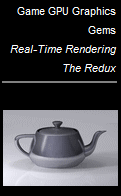We’ve updated our portal page a bit: added Black Rock Studio’s nice publications page, added some film and commercial research labs’ publication pages, and fixed some links. Also, with a bit of regret, I removed the links to the Google Group pages for comp.graphics.algorithms and comp.games.development.programming.algorithms (though the FAQ for c.g.algorithms is still handy). These groups (and I assume most groups in general) have turned into spam repositories. The first group in particular has a special meaning for me, as comp.graphics.* is where I met a lot of graphics programmers back in the 80’s and 90’s and learned a bunch of techniques.
Happily, there are packrats on the internet; Steve Hollasch has a nice collection of the best of comp.graphics and other internet graphics sources. Some web-rot there with the external links, but the comp.graphics postings are solid. A few are dated, but there’s much that is still relevant today. I noticed a page I hadn’t seen before, a SIGGRAPH ’92 satire – some funny bits there (e.g. The Freehand Generation of Fractal Curves using only a Lightpen and Caffeine).
Which reminds me of a classic page that everyone should at least skim: “WARNING: Beware of VIDEA“. It’s about a bogus conference, now long-gone (though the so-called institute that ran it back then still held 23 conferences this year). Werner Purgathofer and colleagues submitted silly abstracts to this conference and all were accepted without review. Check out the abstracts on his page. Werner’s overview page also gives links to a number of related publications scandals: nonexistent peer review, plagiarism, automatic paper writing, etc. If nothing else, check out SCIgen if you haven’t seen it before.


